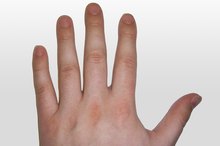What does fact checked mean?
At Healthfully, we strive to deliver objective content that is accurate and up-to-date. Our team periodically reviews articles in order to ensure content quality. The sources cited below consist of evidence from peer-reviewed journals, prominent medical organizations, academic associations, and government data.
The information contained on this site is for informational purposes only, and should not be used as a substitute for the advice of a professional health care provider. Please check with the appropriate physician regarding health questions and concerns. Although we strive to deliver accurate and up-to-date information, no guarantee to that effect is made.
Green Tea for Genital Warts
Green tea for genital warts -- no, you don't brew it and drink it12. Nor can you buy it at your drugstore or purchase it online. A relatively new prescription topical ointment approved by the U.S. Food and Drug Administration in October 2006 contains extract of green tea, which has been shown to be of benefit to those suffering from genital and anal warts12.
About Genital Warts
Genital warts, also known as venereal warts and condylomata acuminata, is a sexually transmitted disease caused by spread of certain strains of the human papillomavirus or HPV, according to MedlinePlus.com1. Genital warts affect one of the tenderest and most personal parts of your body -- the external genitals -- but can also erupt around the anus1. Women can get them inside of the cervix, and both genders can get them inside of the anus as well. The warts may grow close together and have a cauliflower-like conformation. Many genital warts go away without treatment, but if they cause itching, discomfort and bleeding during sexual intercourse, you may want to consider treatment options1.
History of Treatments
How Does Compound W Work?
Learn More
Polyphenon E Ointment, sold under the trade name Veregen T, was released to the public in 2007.
Effectivenessof Treatments
According to NaturalStandard.com, prior to the approval of Polyphenon E Ointment, two randomized, double-blind clinical studies were conducted using 400 adult participants with genital and anal warts1. Participants applied the ointment three times a day. Results of the two studies indicate that the median time required to get rid of genital warts entirely was 16 and 10 weeks, respectively1. Green tea for genital warts may also prove to be a milestone treatment, says the Natural Standard; Polyphenon E Ointment is the first botanical medication to be approved by the FDA under amendments added to federal law in 1962 that require all drugs to be proven both safe and effective before being marketed and sold in the United States12.
使用&副作用
How to Remove Skin Tags With a Wart Remover
Learn More
Typical dosage of Veregen T is about a 0.5 centimeter "strand" applied to the affected area three times daily, says the Veregen website. It should not be used inside the vagina or anus, or applied to broken skin. The ointment should not be washed off before applying the next dose, but if you bathe or shower, make sure to reapply the ointment afterward. Common side effects reported during clinical studies include:
- redness
- burning
- itching
- pain
- ulceration
- inflammation
- hardening of the skin
- Typical dosage of Veregen T is about a 0.5 centimeter "strand" applied to the affected area three times daily, says the Veregen website.
- The ointment should not be washed off before applying the next dose, but if you bathe or shower, make sure to reapply the ointment afterward.
Other
According to data supplied by Bradley Pharmaceuticals, genital warts are "one of the most common and fastest spreading venereal diseases worldwide." Always see a health care provider if you have -- or think you may have -- genital warts1. Other treatments for genital warts consists of cryosurgery and topical imiquimod creams, along with other surgical wart removal procedures and prescription topicals1. Green tea for genital warts may be a good option for you, but beware of imitators -- you can't get this treatment without a prescription1. Ask your doctor if Polyphenon E Ointment is the right option for you.
Related Articles
References
- MedlinePlus.com: Genital Warts
- Natural Standard: FDA Approves Special Green Tea Extract as a New Topical Drug for Genital Warts
- Access Data FDA: Veregen Ointment -- Sinecatechins --Topical Application Route
- 中心Disease Control and Prevention. Genital HPV Infection - Fact Sheet. Updated August 20, 2019.
- 中心Disease Control and Prevention. Chapter 5: Human Papillomavirus (HPV). Updated November 10, 2017.
- 中心Disease Control and Prevention. Condoms and STDs: Fact Sheet for Public Health Personnel. March 5, 2013.
- 中心Disease Control and Prevention. Anogenital Warts. Updated June 4, 2015.
- Kodner CM, Nasraty S. Management of genital warts. Am Fam Physician. 2004;70(12):2335-42.
Writer Bio
丽莎Sefcik此后写作专业1987. Her subject matter includes pet care, travel, consumer reviews, classical music and entertainment. She's worked as a policy analyst, news reporter and freelance writer/columnist for Cox Publications and numerous national print publications. Sefcik holds a paralegal certification as well as degrees in journalism and piano performance from the University of Texas at Austin.








